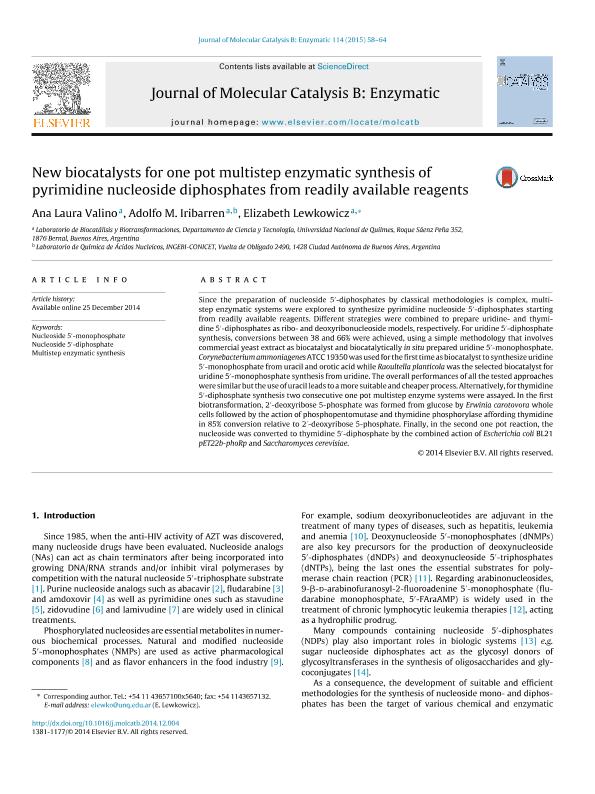Mostrar el registro sencillo del ítem
dc.contributor.author
Valino, Ana Laura

dc.contributor.author
Iribarren, Adolfo Marcelo

dc.contributor.author
Lewkowicz, Elizabeth Sandra

dc.date.available
2018-03-02T18:44:37Z
dc.date.issued
2015-04
dc.identifier.citation
Valino, Ana Laura; Iribarren, Adolfo Marcelo; Lewkowicz, Elizabeth Sandra; New biocatalysts for one pot multistep enzymatic synthesis of pyrimidine nucleoside diphosphates from readily available reagents; Elsevier Science; Journal of Molecular Catalysis B: Enzymatic; 114; 4-2015; 58-64
dc.identifier.issn
1381-1177
dc.identifier.uri
http://hdl.handle.net/11336/37685
dc.description.abstract
Since the preparation of nucleoside 5′-diphosphates by classical methodologies is complex, multistep enzymatic systems were explored to synthesize pyrimidine nucleoside 5′-diphosphates starting from readily available reagents. Different strategies were combined to prepare uridine- and thymidine 5′-diphosphates as ribo- and deoxyribonucleoside models, respectively. For uridine 5′-diphosphate synthesis, conversions between 38 and 66% were achieved, using a simple methodology that involves commercial yeast extract as biocatalyst and biocatalytically in situ prepared uridine 5′-monophosphate. Corynebacterium ammoniagenes ATCC 19350 was used for the first time as biocatalyst to synthesize uridine 5′-monophosphate from uracil and orotic acid while Raoultella planticola was the selected biocatalyst for uridine 5′-monophosphate synthesis from uridine. The overall performances of all the tested approaches were similar but the use of uracil leads to a more suitable and cheaper process. Alternatively, for thymidine 5′-diphosphate synthesis two consecutive one pot multistep enzyme systems were assayed. In the first biotransformation, 2′-deoxyribose 5-phosphate was formed from glucose by Erwinia carotovora whole cells followed by the action of phosphopentomutase and thymidine phosphorylase affording thymidine in 85% conversion relative to 2′-deoxyribose 5-phosphate. Finally, in the second one pot reaction, the nucleoside was converted to thymidine 5′-diphosphate by the combined action of Escherichia coli BL21 pET22b-phoRp and Saccharomyces cerevisiae.
dc.format
application/pdf
dc.language.iso
eng
dc.publisher
Elsevier Science

dc.rights
info:eu-repo/semantics/openAccess
dc.rights.uri
https://creativecommons.org/licenses/by-nc-sa/2.5/ar/
dc.subject
Multistep Enzymatic Synthesis
dc.subject
Nucleoside 5′-Diphosphate
dc.subject
Nucleoside 5′-Monophosphate
dc.subject.classification
Biotecnología Industrial

dc.subject.classification
Biotecnología Industrial

dc.subject.classification
INGENIERÍAS Y TECNOLOGÍAS

dc.title
New biocatalysts for one pot multistep enzymatic synthesis of pyrimidine nucleoside diphosphates from readily available reagents
dc.type
info:eu-repo/semantics/article
dc.type
info:ar-repo/semantics/artículo
dc.type
info:eu-repo/semantics/publishedVersion
dc.date.updated
2018-03-02T14:01:50Z
dc.journal.volume
114
dc.journal.pagination
58-64
dc.journal.pais
Países Bajos

dc.journal.ciudad
Amsterdam
dc.description.fil
Fil: Valino, Ana Laura. Universidad Nacional de Quilmes. Departamento de Ciencia y Tecnología. Area Química. Laboratorio de Biotransformaciones; Argentina. Consejo Nacional de Investigaciones Científicas y Técnicas; Argentina
dc.description.fil
Fil: Iribarren, Adolfo Marcelo. Consejo Nacional de Investigaciones Científicas y Técnicas. Instituto de Investigaciones en Ingeniería Genética y Biología Molecular "Dr. Héctor N. Torres"; Argentina
dc.description.fil
Fil: Lewkowicz, Elizabeth Sandra. Consejo Nacional de Investigaciones Científicas y Técnicas; Argentina. Universidad Nacional de Quilmes. Departamento de Ciencia y Tecnología. Area Química. Laboratorio de Biotransformaciones; Argentina
dc.journal.title
Journal of Molecular Catalysis B: Enzymatic

dc.relation.alternativeid
info:eu-repo/semantics/altIdentifier/doi/http://dx.doi.org/10.1016/j.molcatb.2014.12.004
dc.relation.alternativeid
info:eu-repo/semantics/altIdentifier/url/https://www.sciencedirect.com/science/article/pii/S1381117714003233
Archivos asociados
